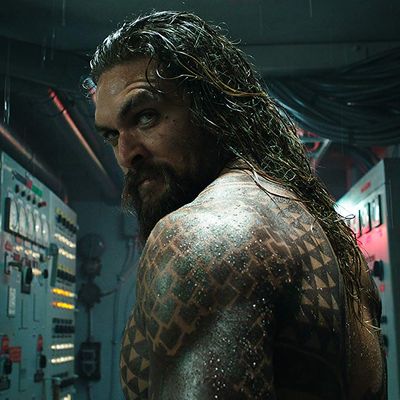
There are some things that, no matter how advanced our moviemaking technology gets, are never going to look “normal” onscreen. When the making of an Aquaman movie became an arc on Hollywood simulacrum Entourage, the subtext to me was always that an Aquaman movie would never be made, so it was fair game as a plot device. I salute the bravery, then, of the folks at the DCEU for diving in, so to speak, and embracing the wacky, airbrush tee-shirt visuals that would be part and parcel of an Aquaman movie whether you made it in 2008 or 2018 or 2048. It sure beats another grimy green-screen paste job in an airport hangar, and it turns out, those visuals are plenty reason to plop down money for a ticket.
So before I get into reviewing Aquaman, to my memory the first DC superhero movie I’ve ever reviewed, I want to get my critical bias out on the table: I love the ocean. I am predisposed to be into anything under the sea. I’ve noticed that I’m not really alone in this bias among fellow ’80s children; Disney’s The Little Mermaid (1989) arrived just as our brains were at prime receptive softness, ready to permanently imprint on undersea palaces and friendly tortoises and glowing jellyfish. It’s all fun and beautiful and spooky in a kind of uncomplicated way. It’s also an environment we’re more used to seeing rendered as animation, computer or otherwise, so it’s more elastic, less bound by some notion of realism (and therefore, of course, more prone to look really, really silly).
The film opens with the origin story of ’80s kid Arthur Curry (Jason Momoa), born to lighthouse keeper Thomas (Temuera Morrison) and Atlanna (Nicole Kidman), the queen of Atlantis, who washes ashore and falls in love with him. Fast-forward, and Arthur has harnessed his inherited Atlantean abilities, despite the absence of his mother, who left her land-family to protect them from the vengeful forces of Atlantis. He’s mostly running around doing small-time maritime superhero stuff: thwarting pirates, saving the Russian navy, etc. He makes the mistake of making enemies with a pirate’s son (unfortunate for him, and for the movie, which is forced to deal with this most boring and un-ocean-y plot thread over the next two hours). Meanwhile, unrest is brewing in the deep: Arthur’s half-brother Orm (Patrick Wilson), current boss of Atlantis, is trying to stir up a war with the people of the land, so that he may consolidate the seven realms of the ocean and crown himself Ocean Master.
There are two kinds of people: those who involuntarily break out into a stupid grin upon hearing the words “Ocean Master,” and those whose hearts are made of stone. I suppose this is a roundabout way of saying that Aquaman is a work of camp — which it is — but I think it’s sneakily hard to pull off this kind of camp when working in such a bloated, global-concern milieu as a tentpole superhero movie. Little things threaten that crystal bubble of camp — particularly Momoa’s “regular dude” one-liners, clearly meant to appease the 8-year-old boys and 8-year-old boys-at-heart in the audience, and the film’s numerous, excessively bone-crunching fight scenes. None of the action is particularly memorable in James Wan’s film, perhaps because the air of unreality permeates the very air/water the characters breathe; the star instead is the fantastical designs and world-building. In the film’s opening act, we’re treated to the sight of Wilson, Willem Dafoe as his adviser Vulko, and Dolph Lundgren as Atlantean noble Nereus, rendezvousing on the backs of iridescent-armored seahorses. It’s a completely unreal, surreal sight, and yet, what would the real version of it even look like?
Arthur is approached by Mera (Amber Heard), daughter of Nereus and Orm’s fiancée, urging him to return to his motherland, unite the sea, and stop his brother’s warmongering — “you are the true king,” etc. Arthur and Mera take a trip in her glowing, clownfish-like aquacar to Atlantis, a spectacular, phosphorescent metropolis in the deep. Their quest for the lost trident of Atlantis — an Arthur’s sword–type plot device that will effectively turn him into the king/resident Aquaman — takes them on an Indiana Jones–lite scavenger hunt to the Sahara Desert (originally an ocean, obviously) and a picturesque Sicilian village where redheaded Mera can have all of her Ariel “Life on land is strange and magical! What are apples!?” moments. Heard doesn’t do much more than hit her marks, give encouraging kisses, and shrug her ruby-red hair out of her face, and Momoa, looking like a very buff Santa Monica busker in his forever-damp henley, embodies the part better than he voices it. But together they work as our tour guides through the increasingly fabulous hidden realms of earth and sea, from a gleaming palace of “Fisherman” merpeople, to a creepy deep-sea trench teeming with the evil cousins of the monster from The Shape of Water, lit by a single red flare.
The film’s finale, the undersea war that was promised, is the first time I can ever remember looking forward to a giant CGI battle, and I can’t wait until someone recuts it to the B-52s “Rock Lobster,” Fred Schneider announcing each new fighting sea creature as it zooms through the deep. Aquaman’s as formulaic, excessively thrashy, and mommy-obsessed as any other entry in the DCEU, but its visual imagination is genuinely exciting and transportive, and dare I say, fun. If you came for the Aquaman mythos, you won’t be disappointed, but if you’re just here for the creatures of the deep, you’ll be more than satisfied.

